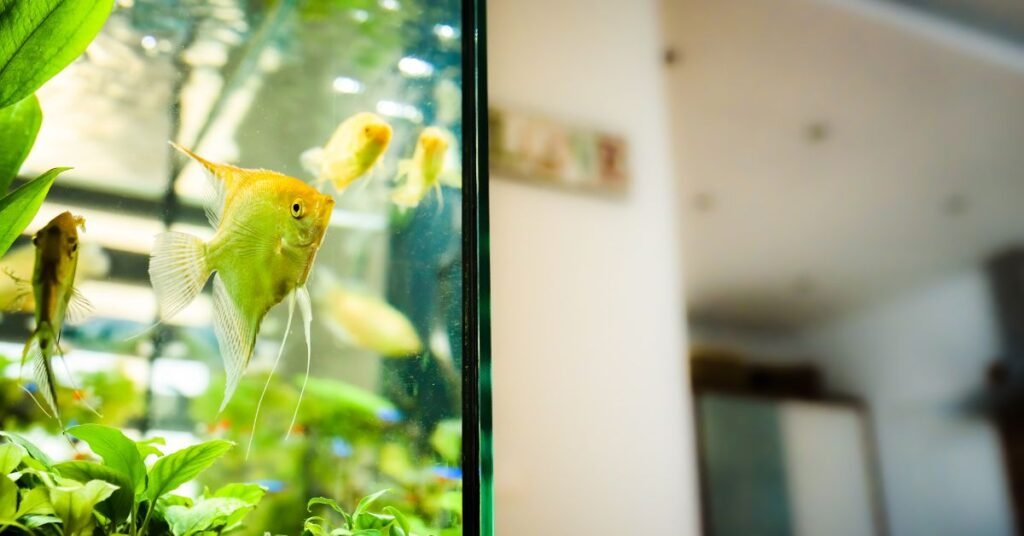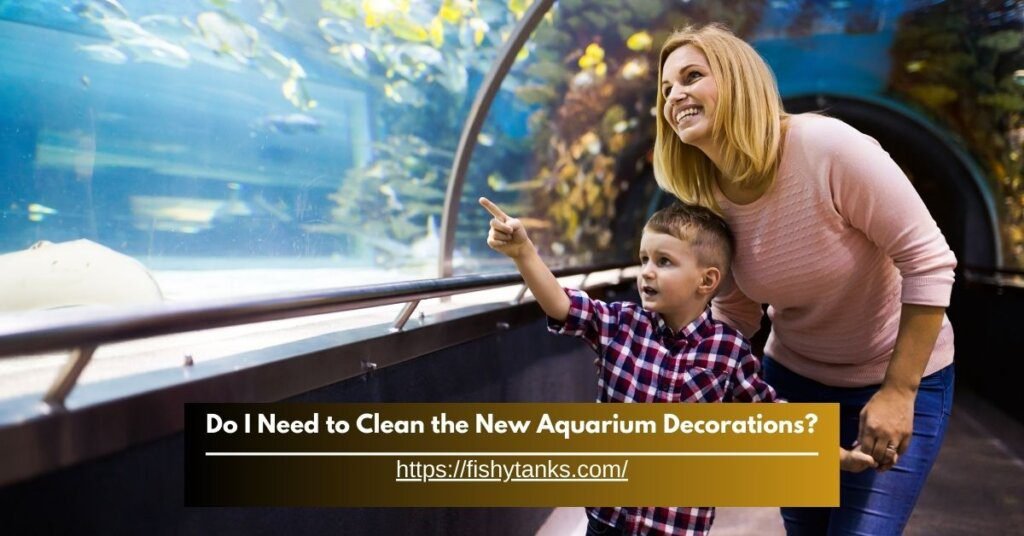When you bring home new aquarium decorations, you want to add them to your tank right away. But, it’s important to take a step back and think about what might be lurking on those decorations. Factories and manufacturing plants can leave behind residue and debris on decorations, which can harm your fish. Some decorations might even have chemicals or dyes that can contaminate your aquarium water. If you don’t clean your decorations properly, you might be introducing harmful substances into your tank. This can make your fish sick or even kill them. Cleaning your decorations before adding them to your tank is crucial for keeping your aquarium healthy and safe. It’s a simple step that can make a big difference in the well-being of your fish. By taking the time to clean your decorations, you can create a happy and healthy environment for your aquatic friends. In this article, we’ll explore the importance of cleaning new aquarium decorations and how to do it effectively.

Why Clean New Aquarium Decorations?
New aquarium decorations might look clean, but they can still harm your fish. Factories and manufacturing plants can leave behind residue and debris on decorations.
This residue can be made up of chemicals, dust, and other tiny particles. If you don’t clean your decorations, these particles can get into your aquarium water.
This can make your fish sick or even kill them. Fish are very sensitive to their environment, and even small amounts of residue can harm them.
Some decorations might even have sharp edges or points that can hurt your fish. If you don’t clean your decorations, you might be introducing harmful substances into your tank.
This can lead to cloudy water, sick fish, and even the growth of harmful bacteria. Cleaning your decorations before adding them to your tank is crucial for keeping your aquarium healthy and safe.
Types of Decorations That Need Cleaning
Different types of aquarium decorations need different types of cleaning.
- Plastic Decorations: Easy to Clean
Plastic decorations, like treasure chests or sunken ships, can be cleaned with a soft brush and mild soap.
- Ceramic Decorations: Delicate Cleaning Required
Ceramic decorations, like ceramic plants or rocks, can be cleaned with a soft cloth and water.
- Live Rock: Special Care Needed
Live rock, which is rock from the ocean, needs to be cleaned carefully to remove any debris or bacteria. It’s important to rinse live rock in a separate container before adding it to your tank.
- Decorations That Require Extra Attention
Some decorations need extra attention because of their design or material.
- Intricate Designs: Traps for Debris and Bacteria
Decorations with intricate designs, like castles or bridges, can trap debris and bacteria in their small spaces. These decorations need to be cleaned with a soft brush and mild soap to remove any dirt or grime.
- Porous Materials: Absorbing Harmful Substances
Decorations made of porous materials, like ceramic or terracotta, can absorb bacteria and debris, which can harm your fish. These decorations need to be cleaned and rinsed thoroughly to remove any harmful substances.

How to Clean New Aquarium Decorations
Step 1: Inspect Your Decorations
Before you start cleaning, take a close look at your new decorations. Check for any dirt, dust, or debris that might be stuck to the surface. This will help you decide the best way to clean them.
Step 2: Rinse with Water
Start by rinsing your decorations with warm water. This will help loosen any dirt or debris that’s stuck to the surface. Use a soft-bristled brush or a clean cloth to gently scrub away any stubborn dirt.
Step 3: Soak in a Cleaning Solution
If your decorations need deeper cleaning, mix a cleaning solution of one part white vinegar with two parts water. Soak your decorations in the solution for about 15 minutes. This will help remove any stubborn bacteria or algae.
Step 4: Scrub and Rinse
Use a soft-bristled brush or a clean cloth to scrub away any remaining dirt or debris. Rinse your decorations thoroughly with warm water to remove any soap or cleaning solution.
Step 5: Dry and Inspect
Once your decorations are clean, use a soft cloth to dry them off. Inspect them one last time to make sure they’re clean and free of any debris.
Importance of Rinsing and Curing
Rinsing your decorations after cleaning is very important. If you don’t rinse them well, leftover soap can harm your fish.
Rinsing helps remove any remaining debris or dirt that might have been missed during cleaning. It’s like washing your hands – you want to make sure they’re really clean.
After rinsing, decorations need to be “cured” to remove any remaining residue or chemicals. Curing is like a special treatment for your decorations.
It helps remove any yucky stuff that might still be on them. To cure your decorations, soak them in a bucket of water for a few days.
This allows any remaining chemicals or residue to leach out into the water. After curing, rinse the decorations again to remove any remaining residue.
This process ensures your decorations are completely clean and safe for your fish. Curing is especially important for decorations made of porous materials like ceramic or terracotta.
These materials can absorb chemicals and bacteria, which can harm your fish. By curing your decorations, you can create a healthy and safe environment for your Fish.

Tips for Maintaining New Aquarium Decorations
- Clean your decorations regularly to prevent dirt and grime from building up.
- Use a soft-bristled brush or a clean cloth to gently scrub away any debris.
- Rinse your decorations thoroughly with warm water to remove any soap or cleaning solution.
- Soak your decorations in a bucket of water for a few days to remove any remaining residue or chemicals.
- Dry your decorations completely before adding them to your aquarium to prevent bacterial growth.
- Avoid using harsh chemicals or abrasive materials that can damage your decorations.
- Inspect your decorations regularly for any signs of damage or wear and tear.
- Replace any damaged or worn-out decorations to keep your aquarium looking its best.
- Keep your aquarium water clean and clear by performing regular water changes and
cleaning your filter.
- Monitor your fish for any signs of stress or illness, and take action if you notice any problems.
Conclusion
Cleaning the new aquarium decorations is an important part of keeping your fish healthy and happy. By following these simple steps, you can keep your decorations clean and free of bacteria and debris. Remember to rinse and cure your decorations before adding them to your aquarium. Regular cleaning and maintenance will keep your decorations looking their best. Clean decorations mean a clean and healthy aquarium. Your fish will thank you for keeping their home clean and safe. Don’t forget to inspect your decorations regularly for any signs of damage or wear and tear. Replacing damaged decorations will keep your aquarium looking its best.
FAQ’s
Q1: Why do I need to clean my aquarium decorations?
Cleaning your aquarium decorations helps remove bacteria, debris, and residue that can harm your fish.
Q2: How often should I clean my aquarium decorations?
Clean your decorations every 1-2 weeks, or as needed. Regular cleaning helps prevent buildup and keeps your aquarium healthy.
Q3: Can I use harsh chemicals to clean my aquarium decorations?
No, avoid using harsh chemicals or abrasive materials that can damage your decorations or harm your fish. Instead, use mild soap and water or a specialized aquarium cleaning solution.
Q4: How do I Avoid debris from accumulating on my aquarium decorations?
Regularly cleaning your decorations and aquarium, plus performing water changes, helps prevent debris buildup. Also, consider using a gravel vacuum to remove debris from the substrate.
Also Read More: What Should the Temperature of a Fish Tank Be for Guppies?



